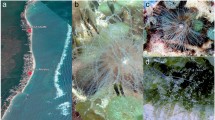Abstract
Cnida discharge in the actinian Anemonia starts with the extrusion of the capsule from the cnidocyte followed by the eversion of the tubule. As the tubule everts, it maintains a tightly closed tip until fully everted. This is considered to be essential for a capsule to discharge as a result of an increase in intracapsular pressure. Venom volumes were measured in 3 types of nematocyst: 408 µm3, 98 µm3, and 9 µm3. Venom flow rates were estimated to range from >43 to 324 µm3 s−1. It is suggested that the intracapsular pressures required for these flow rates range from 9.7 × 105 to 1.9 x 106 Pa.
Similar content being viewed by others
References
Cormier, S. M. & D. A. Hessinger, 1980a. Cnidocil apparatus: sensory receptor of Physalia nematocysts. J. Ultrastruct. Res. 72: 13–19.
Cormier, S. M. & D. A. Hessinger, 1980b. Cellular basis for tentacle adherence in the Portuguese man-of-war (Physalia physahs). Tissue Cell 12: 713–721.
Godknecht, A. & P. Tardent, 1988. Discharge and mode of action of the tentacular nematocysts of Anemonia suleata (Anthozoa: Cnidaria). Mar. Biol. 100: 83–92.
Holstein, T. & P. Tardent, 1984. An ultrahigh-speed analysis of exocytosis: nematocyst discharge. Science, N.Y. 223: 830–833.
Klug, M., J. Weber & P. Tardent, 1989. Hemolytic and toxic properties of Hydra attenuata nematocysts. Toxicon 27: 325–339.
Lubbock, R., B. L. Gupta & T. A. Hall, 1981. Novel role of calcium in exocytosis: mechanism of nematocyst discharge as shown by X-ray microanalysis. Proc. natn. Acad. Sci. U.S.A. 78: 3624–3628.
Mariscal, R. N., 1974. Nematocysts. In L. Muscatine & H. M. Lenhoff (eds), Coelenterate Biology. Academic Press, N.Y.: 129–178.
Mariscal, R. N., C. H. Bigger & R. B. McLean, 1976. The form and function of cnidarian spirocysts: 1. Ultrastructure of the capsule exterior and relationship to the tentacle sensory surface. Cell Tissue Res. 168: 465–474.
Mariscal, R. N., R. B. McLean & C. Hand, 1977. The form and function of cnidarian spirocysts: 2. Ultrastructure of the capsule tip and wall and mechanism of discharge. Cell Tissue Res. 169: 313–321.
Robson, E. A., 1973. The discharge of nematocysts in relation to the properties of the capsule. Publs Seto mar. biol. Lab. 20: 653–665.
Skaer, R. J. & L. E. R. Picken, 1965. The structure of the nematocyst thread and the geometry of discharge in Corynactis viridis Allman. Phil. Trans. r. Soc., Lond. (Ser. B) 250: 131–164.
Tardent, P., 1988. History and current state of knowledge concerning discharge of cnidae. In D. A. Hessinger & H. M. Lenhoff (eds), The Biology of Nematocysts. Academic Press, N.Y.: 309–332.
Tardent, P., T. Holstein, J. Weber & M. Klug, 1985. The morphodynamics and actions of stenotele nematocysts in Hydra. Archs Sci. Genève 38: 401–418.
Thomason, J. C., 1989. Perspectives on the discharge and function of cnidae in the anthozoa. Ph.D. thesis, University of Newcastle upon Tyne.
Thompson, T.., 1976. Biology of opisthobranch molluscs. Ray Society, Lond., 207 pp.
Toot, P., 1988. Kinetics of nematocyst discharge in vitro. M.Sc. thesis, University of Ohio, Athens, USA.
Weber, J., 1989. Nematocysts (stinging capsules of Cnidaria) as Donnan-potential-dominated osmotic systems. Eur. Jl Biochem. 184: 465–476.
Westfall, J. A., 1965. Nematocysts of the sea anemone Metridium. Am. Zool. 5: 377–393.
Yanagita, T. M., 1959. Physiological mechanism of nematocyst response in sea anemone. VII: Extrusion of resting cnidae — its nature and its possible bearing on the normal nettling response. J. exp. Biol. 36:478–494.
Yanagita, T. M., 1960a. Physiological mechanism of nematocyst response in sea anemone. IV: Effects of surface active agents on the cnidae in situ and in isolation. Comp. Biochem. Physiol. 1: 140–154.
Yanagita, T. M., 1960b. Physiological mechanism of nematocyst response in sea anemone. V: The effects of lipoid solvents on the cnidae in situ and in isolation. Annotnes zool. jap. 33: 203–210.
Author information
Authors and Affiliations
Rights and permissions
About this article
Cite this article
Thomason, J.C. Cnida discharge and the mechanism of venom delivery in Anemonia viridis (Cnidaria, Actiniaria). Hydrobiologia 216, 649–654 (1991). https://doi.org/10.1007/BF00026526
Issue Date:
DOI: https://doi.org/10.1007/BF00026526




